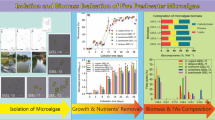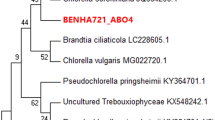Abstract
The microalgae-based water treatment is gaining importance in recent years as it serves multiple purposes of which includes water treatment and biofuel production. Garcinia cambogia, a Malabar tamarind is a tropical fruit and the active ingredient hydroxycitric acid is popularly used as a weight-loss supplement. After extraction of the hydroxycitric acid, the wash water of G. cambogia is considered as an effluent. The potential microalgal species that can grow and treat G. cambogia wash water were isolated and identified as Dicloster acuatus BVR1 and Kalenjenia gelanitosa BVR2. Both the microalgal species adapted to G. cambogia wash water and entered exponential phase after sixth day with maximum specific growth rate of 0.310 day−1 for D. acuatus and 0.296 day−1 for K. gelanitosa during tenth day. The biomass productivity of D. acuatus was 0.03 g L−1 day−1 which is 58% higher than K. gelanitosa with 0.019 g L−1 day−1. The microalgal strains besides water treatment were subsequently subjected for lipid extraction and lipid productivity determination. The lipid productivity of D. acuatus was 2.68 mg L−1 day−1 which is lesser compared to 3.38 mg L−1 day−1 for K. gelatinosa. Both the microalgal isolates were promising for G. cambogia wash water treatment and lipid production. Hence, an environment friendly approach of water treatment with simultaneous lipid production for biofuel conversion is conducted.




Similar content being viewed by others
References
Amit & Ghosh, U.K. (2018) An approach for phycoremediation of different wastewaters and biodiesel production using microalgae. Environ Sci Pollut Res. https://doi.org/10.1007/s11356-018-1967-5
An SS, Friedl T, Hegewald E (1999) Phylogenetic relationships of Scenedesmus and Scenedesmus-like Coccoid green algae as inferred from ITS-2 rDNA sequence comparisons. Plant Biol 1:418–428
Ansari AA, Khoja AH, Nawar A, Qayyum M, Ali E (2017) Wastewater treatment by local microalgae strains for CO2 sequestration and biofuel production. Appl Water Sci 7:4151–4158
Aravantinou AF, Theodorakopoulos MA, Manariotis ID (2013) Selection of microalgae for wastewater treatment and potential lipids production. Bioresour Technol 147:130–134
Chen CY, Yeh KL, Aisyah R, Lee DJ, Chang JS (2011) Cultivation, photobioreactor design and harvesting of microalgae for biodiesel production: a critical review. Bioresour Technol 102:71–81. https://doi.org/10.1016/j.biortech.2010.06.159
Chinnasamy S, Bhatnagar A, Hunt RW, Das KC (2010) Microalgae cultivation in a wastewater dominated by carpet mill effluents for biofuel applications. Bioresour Technol 101(9):3097–3105
Converti A, Casazza AA, Ortiz EY, Perego P, del Borghi M (2009) Effect of temperature and nitrogen concentration on the growth and lipid content of Nannochloropsis oculata and Chlorella vulgaris for biodiesel production. Chem Eng Process Process Intensif 48:1146–1151. https://doi.org/10.1016/j.cep.2009.03.006
de Morais M, Costa J (2007) Isolation and selection of microalgae from coal fired thermoelectric power plant for biofixation of carbon dioxide. Energy Convers Manag 48(7):2169–2173
Folch J, Lees M, Sloane Stanley G (1957) A simple method of isolation and purification of total lipids from animal tissues. J Biol Chem 226:497–509
Griffiths MJ, Harrison STL (2009) Lipid productivity as a key characteristic for choosing algal species for biodiesel production. J Appl Phycol 21:493–507
Hayamizu K et al (2003) Effects of garcinia Cambogia (hydroxycitric acid) on visceral fat accumulation: a double-blind, randomized, placebo-controlled trial. Curr Ther Res Clin Exp 64(8):551–567
Iram S, Kanwal S, Ahmad I, Tabassam T, Suthar V, Mahmood-UlHassan M (2013) Assessment of physicochemical parameters of wastewater samples. Environ Monit Assess 185(3):2503–2515
Jayaprakasha GK et al (2007) Determination of (−) hydroxycitric acid in commercial samples of Garcinia cambogia extract by liquid chromatography with ultraviolet detection. J Liq Chromatogr Relat Technol 23(6):915–923
Kamalanathan M, Pierangelini M, Shearman LA, Gleadow R, Beardall J (2016) Impacts of nitrogen and phosphorus starvation on the physiology of Chlamydomonas reinhardtii. J Appl Phycol 28(3):1509–1520
Koutra E, Grammatikopoulos G, Kornaros M (2018) Selection of microalgae intended for valorization of digestate from agro-waste mixtures. Waste Manag 73:123–129
Lee K, Eisterhold ML, Rindi F, Palanisami S, Nam PK (2014) Isolation and screening of microalgae from natural habitats in the Midwestern United States of America for biomass and biodiesel sources. J Nat Sci Biol Med 5:333–339
Perez-Castineira JR, Prieto JL, Vega JM (1992) Sulfate uptake in Chlamydomonas reinhardtii. Phyton (Austria) 32(3):91–94
Pinto E, Sigaud-kutner TCS, Leitão MAS, Okamoto OK, Morse D, Colepicolo P (2003) Heavy metal–induced oxidative stress in algae. J Phycol 39(6):1008–1018
Pires JCM, Alvim-Ferraz MCM, Martins FG, Simões M (2013) Wastewater treatment to enhance the economic viability of microalgae culture. Environ Sci Pollut Res 20(8):5096–5105
Ravikumar R, Karthik V (2015) Effective utilization and conversion of spent distillery liquid to valuable products using an intensified technology of two stage biological sequestration. Chem Biochem Eng Q 29(4):599–608
Ravikumar R, Renuka K, Sindhu V, Malarmathi KB (2013) Response surface methodology and artificial neural network for modeling and optimization of distillery spent wash treatment using Phormidium valderianum BDU 140441. Pol J Environ Stud 22(4):1143–1152
Samorì G, Samorì C, Guerrini F, Pistocchi R (2013) Growth and nitrogen removal capacity of Desmodesmus communis and of a natural microalgae consortium in a batch culture system in view of urban wastewater treatment: part I. Water Res 47(2):791–801
Selvarajan R, Felföldi T, Tauber T, Sanniyasi E, Sibanda T, Tekere M (2015) Screening and evaluation of some green algal strains (Chlorophyceae) isolated from freshwater and soda lakes for biofuel production. Energies 8:7502–7521
Selvarajan R, Felfoldi T, Sanniyasi E, Tekere M (2016) Assessing the potential of some freshwater and saline microalgae as biodiesel feedstock. J Biobased Mater Bioenergy 10:1–13
Sharma AK, Sahoo PK, Singhal S, Patel A (2016) Impact of various media and organic carbon sources on biofuel production potential from Chlorella spp. 3 Biotech 6:116. https://doi.org/10.1007/s13205-016-0434-6
Tsolcha ON, Tekerlekopoulou AG, Akratos CS, Antonopoulou G, Aggelis G, Genitsaris S, Moustaka-Gouni M, Vayenas DV (2018) A Leptolyngbya-based microbial consortium for agro-industrial wastewaters treatment and biodiesel production. Environ Sci Pollut Res. https://doi.org/10.1007/s11356-018-1989-z
Wang L, Min M, Li Y, Chen P, Chen Y, Liu Y, Wang Y, Ruan R (2010) Cultivation of green algae Chlorella sp. in different wastewaters from municipal wastewater treatment plant. Appl Biochem Biotechnol 162(4):1174–1186
Zhang S, Liu P, Yang X, Hao Z, Zhang L, Luo N, Shi J (2014) Isolation and identification by 18S rDNA sequence of high lipid potential microalgal species for fuel production in Hainan Dao. Biomass Bioenergy 66:197–203. https://doi.org/10.1016/j.biombioe.2014.01.015
Acknowledgements
The authors gratefully acknowledge the Management of Bannari Amman Institute of Technology, Sathyamangalam for providing wonderful infrastructure facilities to carry out the research work.
Funding
The research work was funded by the Department of Science and Technology, Government of India with reference number SR/FTP/ETA-0099/2014.
Author information
Authors and Affiliations
Corresponding author
Additional information
Responsible editor: Philippe Garrigues
Electronic supplementary material
ESM 1
(DOC 27 kb)
Rights and permissions
About this article
Cite this article
Budhi Venkatesan, R., Rajarathinam, R. Screening of microalgae for treating Garcinia cambogia wash water with potential lipid production. Environ Sci Pollut Res 26, 34685–34692 (2019). https://doi.org/10.1007/s11356-018-2597-7
Received:
Accepted:
Published:
Issue Date:
DOI: https://doi.org/10.1007/s11356-018-2597-7




